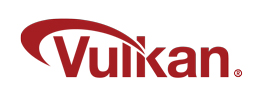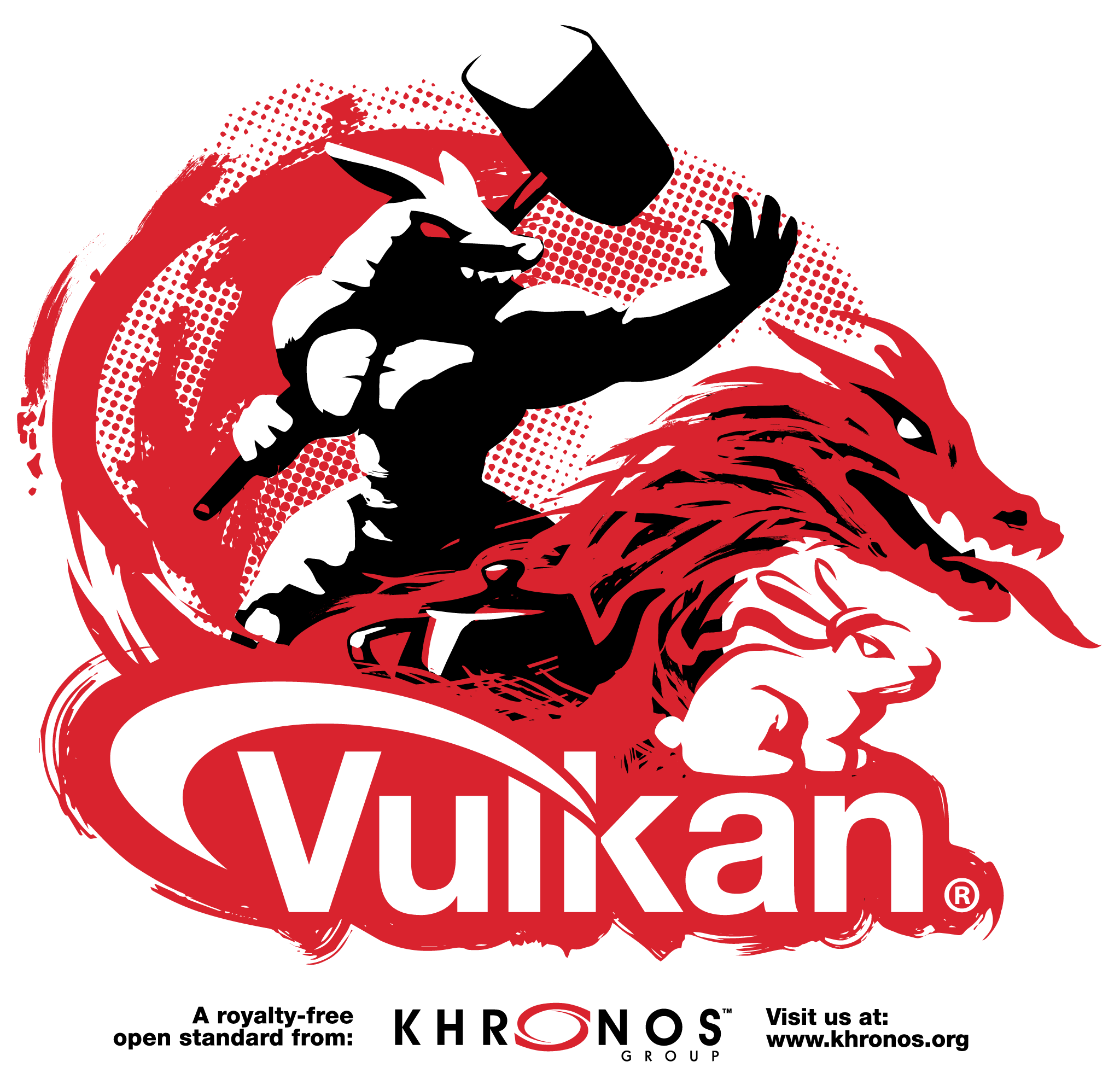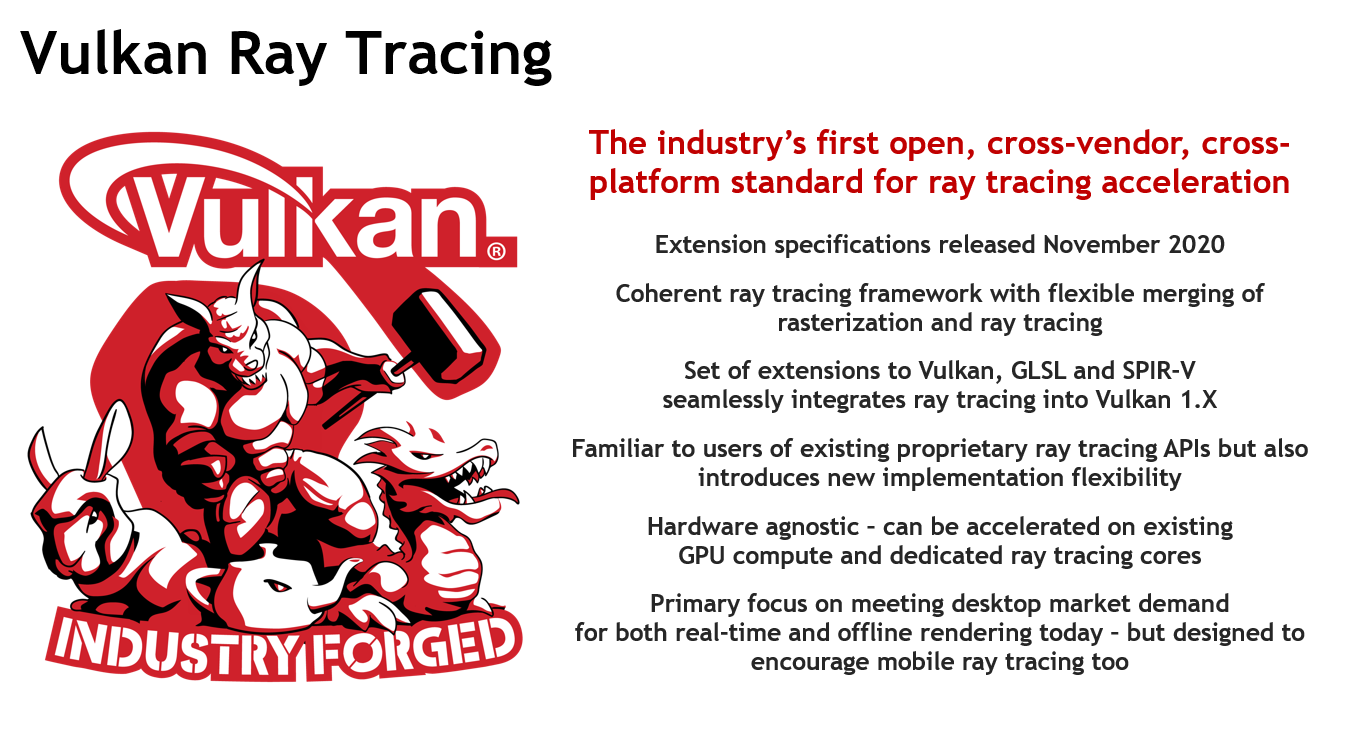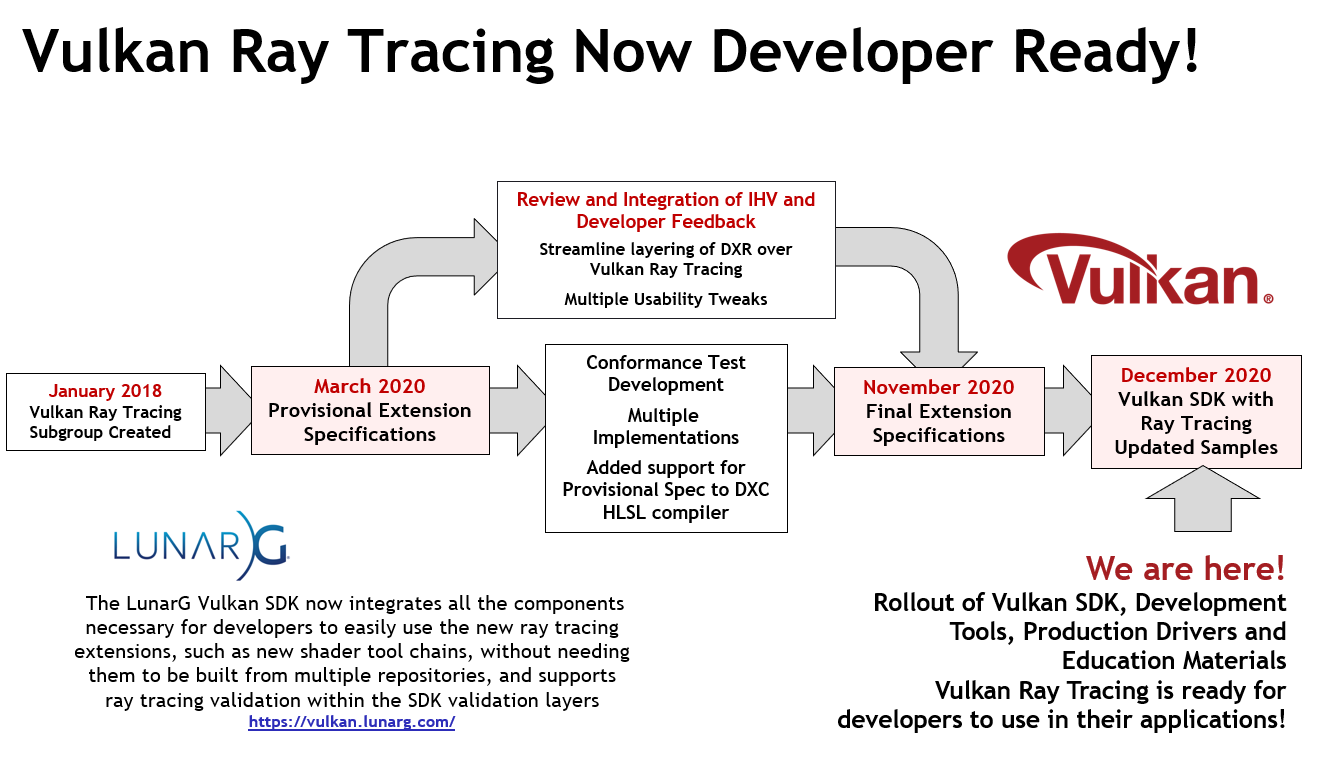Vulkan SDK, Tools and Drivers are Ray Tracing Ready
Vulkan SDK shipping today with ray tracing support including Validation Layers. Shader tools, samples and developer guide upgraded to support Vulkan Ray Tracing. Production drivers shipping from multiple GPU vendors.
Beaverton, OR – December 15, 2020 – 6:00 AM PT – Today, The Khronos® Group, an open consortium of industry-leading companies creating advanced interoperability standards, announces that LunarG has released the Vulkan Software Development Kit (SDK) version 1.2.162.0, with full support for the new Vulkan Ray Tracing extensions, including Validation Layers and integration of upgraded GLSL, HLSL and SPIR-V shader tool chains. The Khronos open source Vulkan Samples and Vulkan Guide have been upgraded to illustrate ray tracing techniques. Finally, with production drivers shipping from both AMD and NVIDIA, developers are now enabled to easily integrate Vulkan Ray Tracing into their applications.
Khronos released final Vulkan Ray Tracing extensions in November 2020 to seamlessly integrate ray tracing functionality alongside Vulkan’s rasterization framework, making Vulkan the industry’s first open, cross-vendor, cross-platform standard for ray tracing acceleration. Vulkan Ray Tracing can be deployed using existing GPU compute or dedicated Ray Tracing cores. The Vulkan SDK now integrates all the components necessary for developers to easily use the new ray tracing extensions, such as new shader tool chains, without needing them to be built from multiple repositories, and supports ray tracing validation within the SDK validation layers.
“Shipping API specifications was just the first step in building the developer ecosystem for Vulkan Ray Tracing, we now have tools and samples to truly enable developers to tap into the power of cross-platform ray tracing acceleration,” said Daniel Koch, senior graphics system software engineer at NVIDIA and Vulkan Ray Tracing TSG chair at Khronos. “One of the key requests from the developer community was the ability to easily bring DirectX 12 ray tracing (DXR) code to Vulkan. We have achieved that through delivering a carefully designed superset of DXR, and integrating Vulkan Ray Tracing support in the DXC open source HLSL compiler.”
As outlined earlier this year, production-ready use of HLSL in Vulkan has been achieved through integrating a SPIR-V backend into DXC, Microsoft’s open source HLSL compiler. Support for Vulkan Ray Tracing has now been integrated into DXC, enabling developers to use HLSL shaders in Vulkan ray tracing applications, including porting ray tracing applications to Vulkan from DXR. Vulkan is also used as a backend for layered implementations of APIs such as DirectX 12. Through the design of Vulkan Ray Tracing, projects such as vkd3d-Proton will be able to efficiently support layered DXR over Vulkan.
Production Vulkan drivers that include the Vulkan Ray Tracing extensions are now shipping for both AMD and NVIDIA GPUs, starting with the AMD Radeon Adrenalin 20.11.3 and NVIDIA R460 drivers for both GeForce and Quadro on Windows and Linux. The Vulkan Ray Tracing extensions will also be supported by Intel Xe-HPG GPUs, available in 2021, with driver support provided via regular driver updates.
Additional informative materials include blogs and tutorials from Khronos and members:
Description of the Vulkan Ray Tracing Extensions
How to use the Vulkan Ray Tracing extensions
Vulkan Hybrid Rendering Best Practices
NVIDIA Vulkan Ray Tracing Tutorial
NVIDIA Mini Path Tracer Tutorial
NVIDIA Open Source Vulkan Ray Tracing-based glTF Viewer
Quake II RTX using Vulkan Ray Tracing source on GitHub
Holochip’s use of Vulkan Ray Tracing for Light Field Rendering
The Khronos Group is actively monitoring developer feedback on the Vulkan Ray Tracing extension and ecosystem artifacts through the Vulkan issues tracker on GitHub.
Industry Support for Vulkan Ray Tracing
“4A Games was one of the earliest adopters of hardware level ray tracing by developing the first Real-Time Raytraced Global Illumination system in a video game as released in Metro Exodus, and we are excited at the addition of a vendor agnostic Vulkan implementation in the industry. We look forward to seeing how this technology progresses,” said Oleksandr “Oles” Shyshkovtsov, CTO, 4A Games.
“Standardizing ray tracing in Vulkan is an important step towards making ray tracing available across a wide range of devices, as well as enabling developers to use this technology to its full advantage. AMD supports all of the major features in this extension, including ray shading and ray queries in our AMD Radeon Software Adrenalin Edition driver. We are also working with developers to ensure great performance from our Vulkan Ray Tracing implementation thanks to hardware ray tracing support on AMD RDNA™ 2 architecture-based graphics cards; these efforts will help us to provide end-users with even more visually stunning graphics on AMD Radeon™ graphics cards,” said Andrej Zdravkovic, senior vice president, software development, AMD.
“During the development of Rage 2 and other games, Vulkan gave us great flexibility when looking at deployment on multiple platforms. As the Apex Engine looks to adopt and avail of the latest hardware developments, it is great to see Vulkan keeping pace and investing in support for cutting edge features like hardware accelerated ray tracing,” said John Fuller, managing director, Avalanche Studios Group.
“Being one of the first adopters of Vulkan in our Rocksolid Engine already in 2015, we’re thrilled to now add support for Vulkan Ray Tracing. The first product to feature raytraced effects like reflections and global illumination will be the forthcoming GPUScore benchmark. We’re also working to introduce ray tracing for automotive instrument clusters and other in-car screens and Vulkan Ray Tracing extensions are important enablers for this,” said Tero Sarkkinen, Founder and Chairman of the Board of Basemark.
“Blender’s mission is to get the best of the world’s CG technology in the hands of artists as free/open source software. Industry-wide accepted open standards are essential for our goal. For that reason I’m proud to see the industry having agreed on the Vulkan ray tracing API. This is going to be huge! For us, the upcoming ray tracing functionality was a big motivation for why we are working on Vulkan real-time rendering already since 2019,” said Ton Roosendaal, chairman Blender Foundation.
“In the past 20 years, rasterization techniques were at the core of innovation in real-time rendering. At Crytek, the Vulkan API is playing a major part in driving advancements in this area, helping us to deliver a high-performance game-engine with outstanding visuals across different platforms and operating systems. We are pleased that Khronos is releasing vendor-independent Vulkan Ray Tracing extensions that define essential functionality for bringing real-time ray tracing to Vulkan supported applications. Similar to the rasterization domain, this extension plays a major part in our plans for offering cutting edge ray-tracing functionality in CRYENGINE, while benefiting greatly from hardware-specific implementations of each vendor,” said Theodor Mader, technical director, CRYENGINE/Crytek.
“With the 3DEXPERIENCE Platform Dassault Systèmes provides business and people with virtual universes to imagine sustainable innovations for today and tomorrow. Our rendering technology serves a multitude of industries and use-cases, ranging from high-performance, real-time scenarios to high-quality GI and physical light simulation. Vulkan Ray Tracing enables us to bring hardware accelerated ray tracing into the hands of our users in a cross-platform and vendor agnostic way. This is huge!” said Nicolas Jean, R&D technology rendering manager, Dassault Systèmes.
“At EA we inspire the world to play and are dedicated to jointly developing open standards that empower developers to push creative boundaries for compute and graphics, like Vulkan Ray Tracing. We are excited about this release from Khronos as it will pioneer future innovations that deliver extraordinary experiences for players.” said Colin Barré-Brisebois, head of technology at SEED, Electronic Arts.
“At Epic Games we have always been committed to the advancement of open standards and cross-platform systems that give people freedom of choice and control over their creativity. As early adopters of ray tracing technologies we are thrilled to see Khronos releasing Vulkan Ray Tracing extensions as part of the Vulkan SDK and we’re excited about the possibilities that this release opens up for Unreal Engine creators.” said Juan Cañada, Ray Tracing Lead Engineer, Epic Games.
“Holochip develops light field technology for the U.S. military and is incorporating glasses-free 3D visualization capabilities into existing environments. The Vulkan SDK Ray Tracing release will enable wide adoption of Holochip’s real-time light-field rendering solutions across numerous display devices – from headsets, lenticular screen, tabletop, CAVE and volumetric displays to next-generation holographic and other 3D displays. This release paves the way for military environments to benefit from the technical advances in the commercial 3D imaging and ray tracing markets. These advances will provide greater situational awareness across land, sea, space and cyber, leading to greater effectiveness, cost savings and risk reduction in areas such as Command and Control (C2), planning, training, maintenance and medicine. Click here to learn more about Holochip’s real-time light-field rendering solutions,” said Robert Batchko CEO of Holochip Corporation.
“Imagination Technologies has a decade-long commitment to creating innovative ray tracing hardware IP across a wide spectrum of platforms. The release of Vulkan’s ray tracing framework will give developers unrivalled freedom to create applications across our hardware platforms and provide new, unique graphical experiences on a variety of upcoming mobile devices,” said Mark Butler, vice president of software engineering Imagination Technologies.
“At Intel Architecture Day 2020, we announced that new GPUs based on the gaming-optimized Xe-HPG architecture will be available in 2021 and feature hardware acceleration for ray tracing. We’re thrilled to see Khronos push graphics forward with new ray tracing extensions and we look forward to providing driver updates and additional details when we launch next year,” said Lisa Pearce, vice president, Intel Architecture, graphics and software.
“The Glacier Engine has a Vulkan backend that powers HITMAN3 on Stadia. At IO Interactive we follow with interest the evolution of the API and the upcoming extensions. Ray Tracing is a topic we’re actively working on for our games, so we’re very excited to see hardware agnostic support coming into Vulkan,” said Maurizio De Pascale, CTO, IO Interactive A/S.
“The arrival of a vendor agnostic approach to hardware accelerated ray tracing in Vulkan will impact our industry in a similar fashion as the arrival of hardware transform & lighting, flexible shaders, or compute shaders did. I for one am looking forward to seeing how it’s going to be used,” said Jim Kjellin, CTO, MachineGames AB.
“NVIDIA has taken a leadership role in bringing ray tracing to Vulkan, enabling developers with cross-platform access to RTX acceleration. Today we are rolling out Vulkan Ray Tracing in our production drivers and have upgraded Quake II RTX to be the world’s first cross-vendor ray tracing Vulkan application,” said Dwight Diercks, senior vice president of software engineering, NVIDIA.
“Vulkan Ray Tracing is a milestone for the computer graphics industry at large. For the first time, graphics developers are able to leverage hardware ray tracing through a fully performant, cross platform and vendor agnostic API. OTOY is thrilled to have participated in the Khronos Group’s development and ratification of the new Vulkan Ray Tracing extensions. We are actively using these extensions to deploy future Vulkan versions of OctaneRender – OTOY’s industry-leading cinematic GPU spectral path-tracer – as well as forthcoming Vulkan releases of OTOY’s AnimeRender, Brigade, Sculptron and RNDR,” said Jules Urbach, CEO, OTOY Inc.
“Quantic Dream are currently implementing ray tracing into our upcoming projects with the help of the new Vulkan ray tracing extensions. It allows us to improve our graphics tremendously and we can’t wait to share the results! In general we find the arrival of vendor agnostic ray tracing to be an excellent development for the industry,” said Ronan Marchalot, Quantic Dream.
“Rebellion has been one of the earliest adopters of Vulkan and we did this to further our development goals and to provide greater flexibility to our teams. We are delighted with the arrival of vendor-agnostic ray tracing in Vulkan and we are excited to see how it develops,” said Chris Kingsley OBE, co-founder and CTO, Rebellion Developments.
“SiliconArts is excited to support the Vulkan cross platform ray tracing API with options for hybrid rendering. This expands the potential for both content creators and new cloud and client rendering architectures,” Dr. Hyungmin Yoon, CEO and founder, SiliconArts.
“The arrival of a hardware agnostic ray tracing API is a great development for the graphics industry, arguably it’s one of the most exciting things to have happened in recent years. At Traverse Research, we’re heavily invested in the future of ray tracing as a technology and we are able to bring our expertise in this area to a range of companies. We’re very excited about this announcement, and have been involved in this effort since its earliest days,” said Jasper Bekker, founder, Traverse Research.
“Cross-platform raytracing is a big deal. We are excited about the possibilities this opens up for our partners and customers,” said Don Holden, software engineer, Valve.
About Vulkan
Vulkan is an open, royalty-free API for high-efficiency, cross-platform access to modern GPUs, with widespread adoption in leading engines, cutting-edge games, and demanding applications. Vulkan is supported in a diverse range of devices from Windows and Linux PCs, consoles, and the cloud, to mobile phones and embedded platforms.





